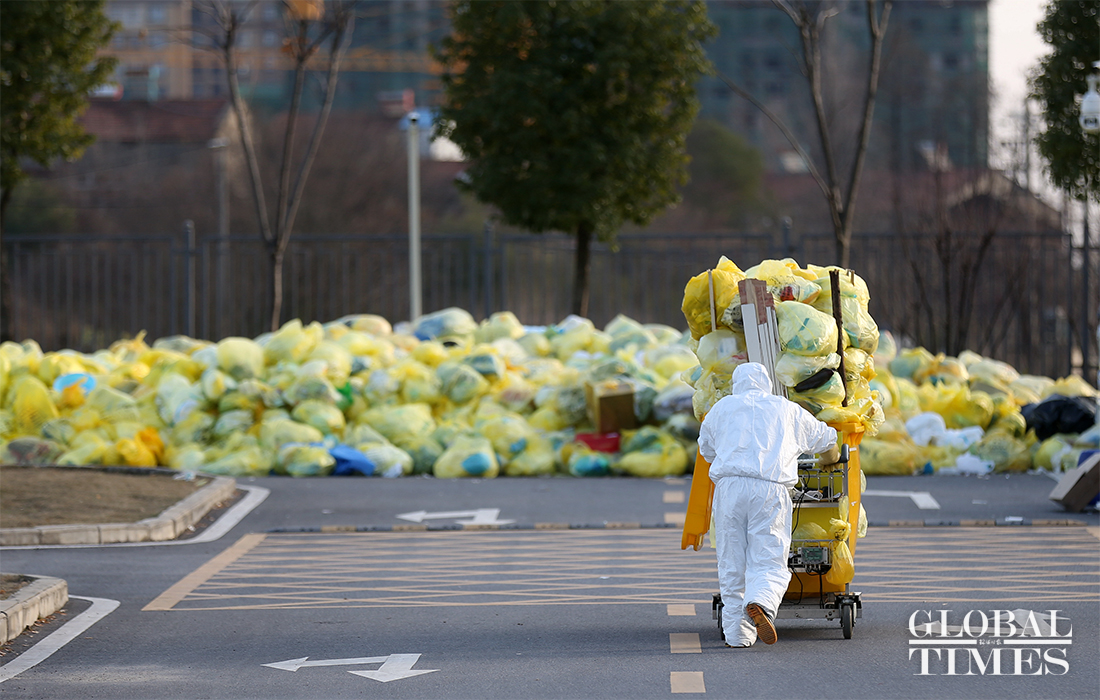Editor's Note:
With the COVID-19 ravaging Wuhan, medical waste has doubled in the city with many hospitals' storage facilities filled to the brim. Apart from the frontline medical staff battling against the epidemic, infectious medical waste handlers are also the ones vulnerable to the virus infection. These workers are often exposed to contaminated materials, such as used protective suits, masks, gloves, instruments, and even vomit. They work about 12 hours a day. Due to the large quantities of medical waste in Wuhan, garbage disposal teams from many other cities and provinces have been drafted in to offer a hand in the fight against the epidemic. Wuhan's current medical waste disposal capacity has increased from the previous 50 tons per day to more than 100 tons per day. Medical wastes are disposed of under strict regulations. Photos: Cui Meng/GT
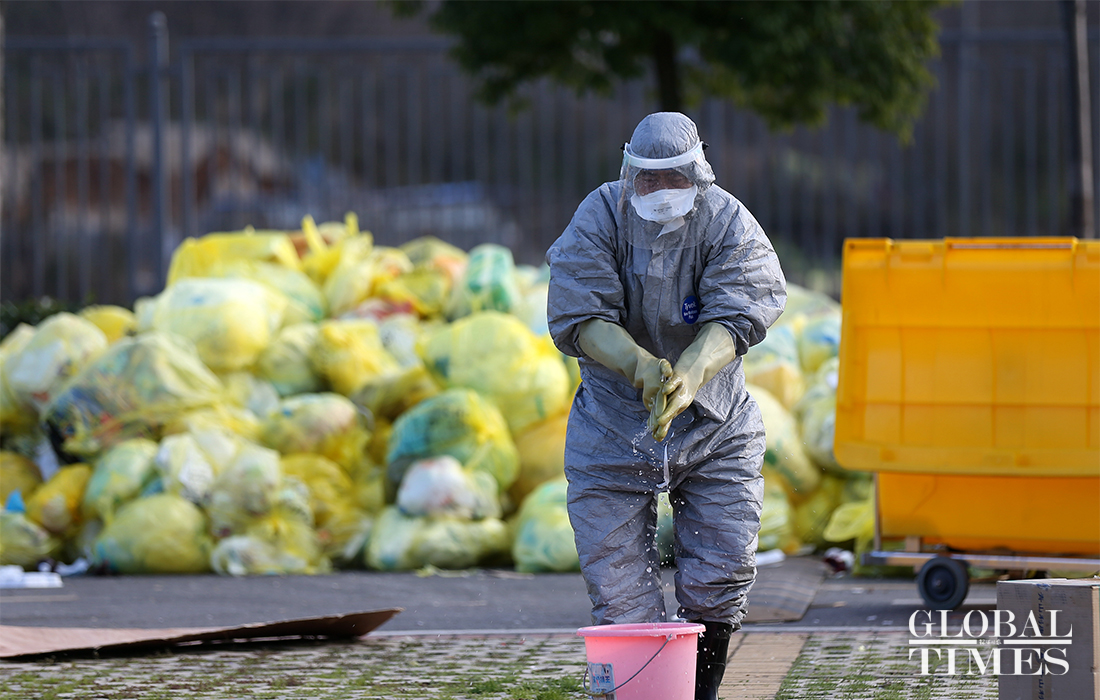 A worker washes his protective gloves with disinfectant in the Zhongfa Xincheng branch of Wuhan Tongji Hospital on February 18. Photo: Cui Meng/GT
A worker washes his protective gloves with disinfectant in the Zhongfa Xincheng branch of Wuhan Tongji Hospital on February 18. Photo: Cui Meng/GT 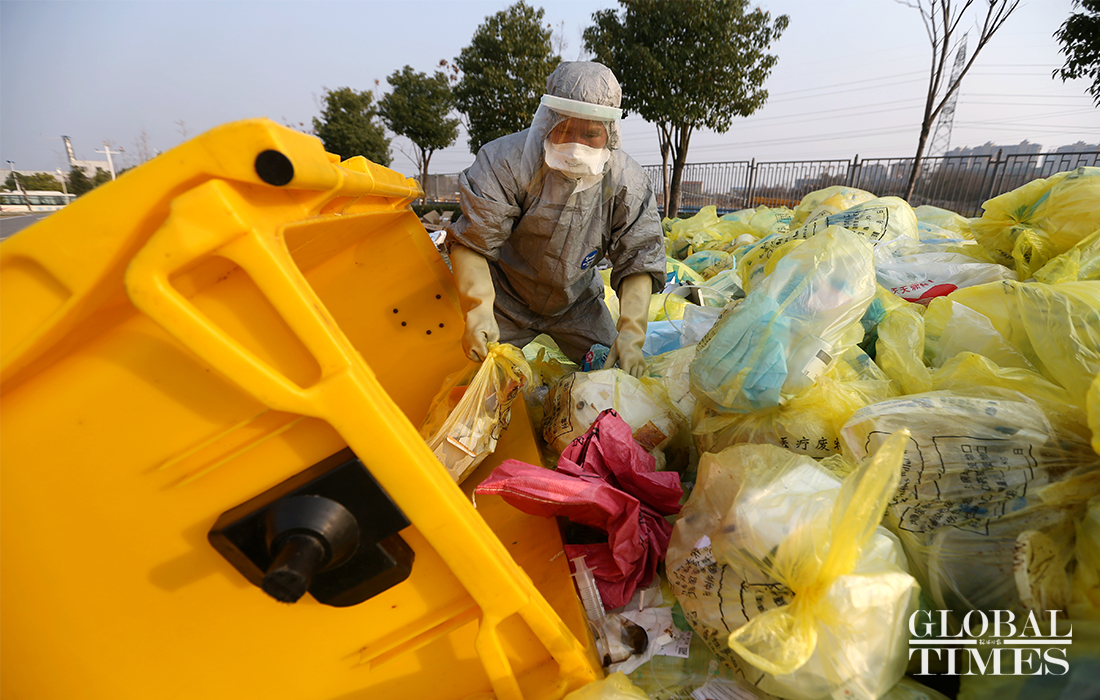 A worker empties an ashcan to pour out the garbage at the temporary medical waste storage point in the Zhongfa Xincheng branch of Wuhan Tongji Hospital on February 18. Photo: Cui Meng/GT
A worker empties an ashcan to pour out the garbage at the temporary medical waste storage point in the Zhongfa Xincheng branch of Wuhan Tongji Hospital on February 18. Photo: Cui Meng/GT 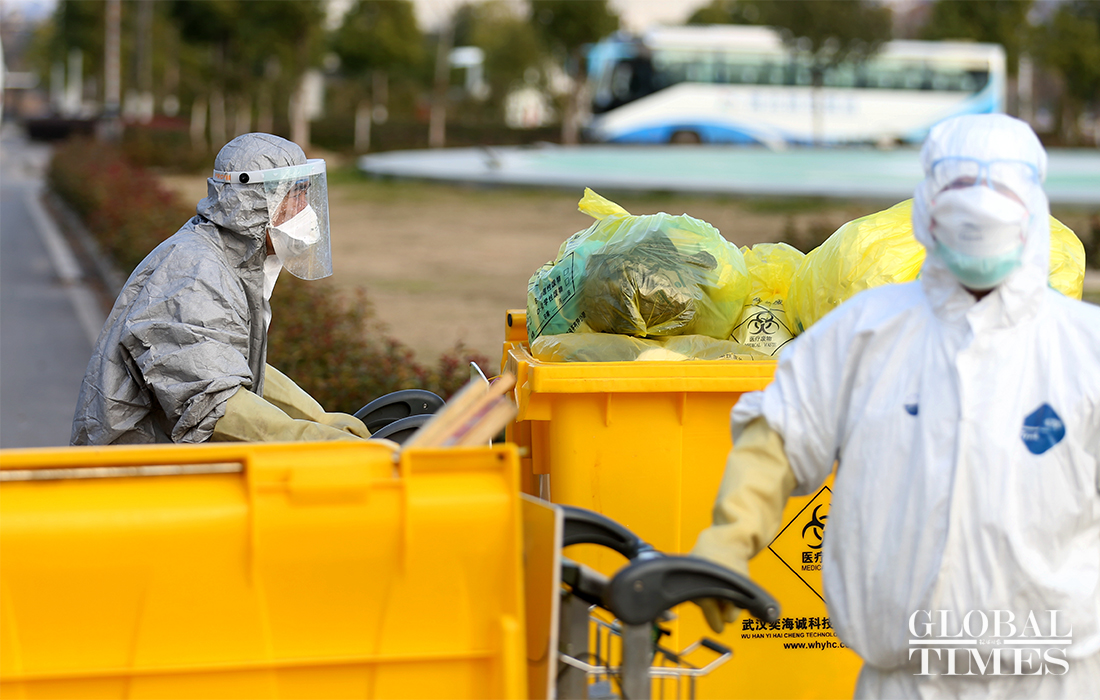 Workers transport medical waste from the Zhongfa Xincheng branch of Wuhan Tongji Hospital on February 18. Photo: Cui Meng/GT
Workers transport medical waste from the Zhongfa Xincheng branch of Wuhan Tongji Hospital on February 18. Photo: Cui Meng/GT 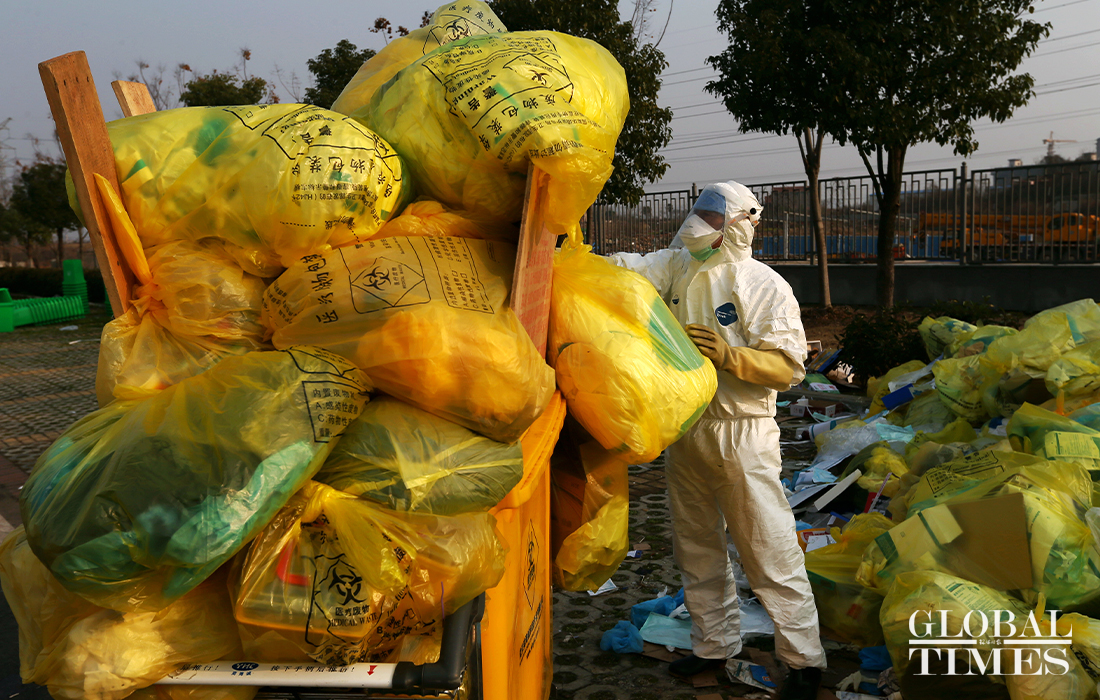 A worker collects waste bags from an ashcan and assembles them in the temporary medical waste storage point in the Zhongfa Xincheng branch of Wuhan Tongji Hospital, on February 21. Photo: Cui Meng/GT
A worker collects waste bags from an ashcan and assembles them in the temporary medical waste storage point in the Zhongfa Xincheng branch of Wuhan Tongji Hospital, on February 21. Photo: Cui Meng/GT 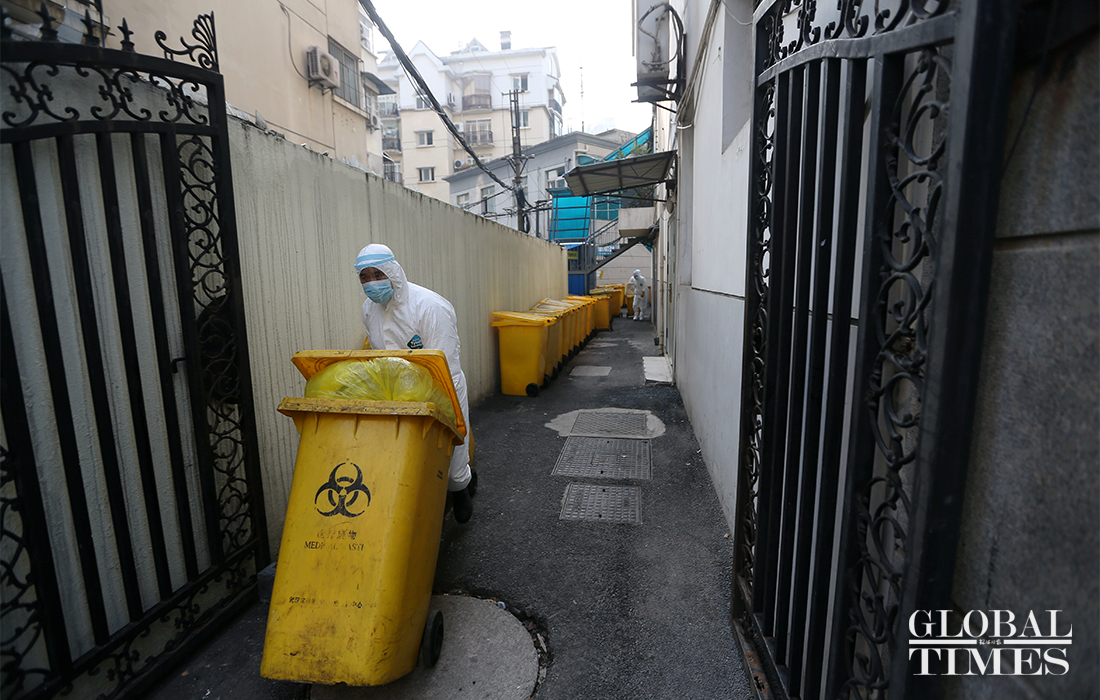 A worker arranges garbage bins containing medical waste to load them in a truck and transport to the disposal point, in Wuhan Red Cross Society Hospital, on Feb 22. Photo: Cui Meng/GT
A worker arranges garbage bins containing medical waste to load them in a truck and transport to the disposal point, in Wuhan Red Cross Society Hospital, on Feb 22. Photo: Cui Meng/GT 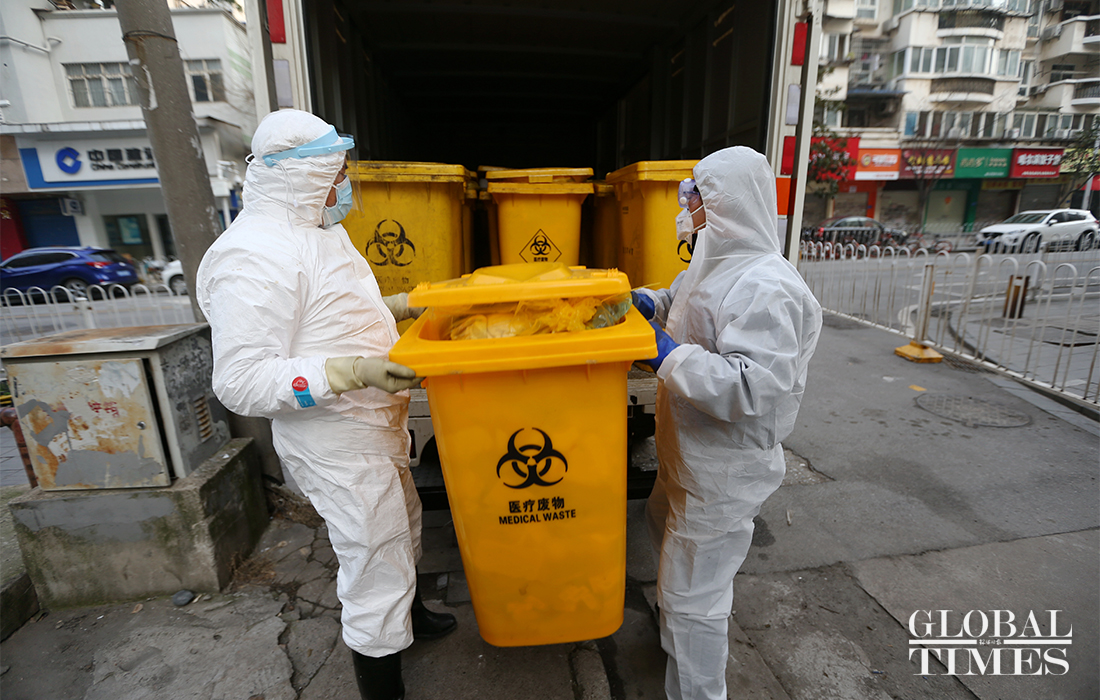 Workers from the Hubei Zhongyou Youyi Environmental Protection Technology company in Xiangyang city, load medical waste bins onto a truck on Feb 22. This company has dispatched 92 professional handlers and 35 transfer vehicles to Wuhan for medical waste disposal. Photo: Cui Meng/GT
Workers from the Hubei Zhongyou Youyi Environmental Protection Technology company in Xiangyang city, load medical waste bins onto a truck on Feb 22. This company has dispatched 92 professional handlers and 35 transfer vehicles to Wuhan for medical waste disposal. Photo: Cui Meng/GT 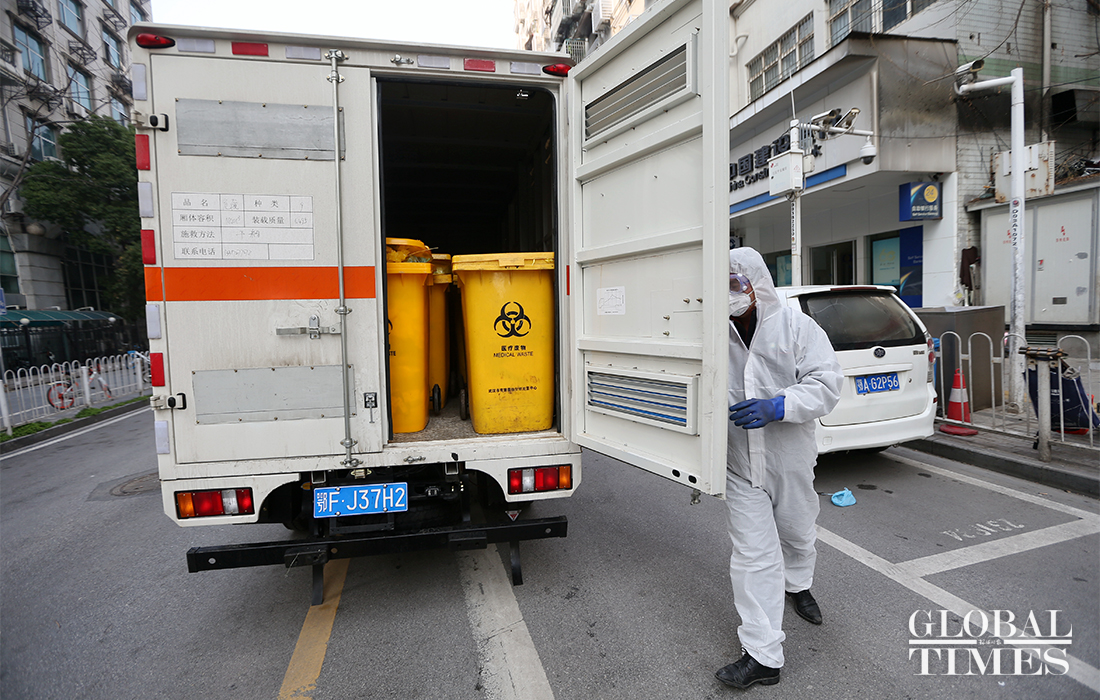 A worker from the Hubei Zhongyou Youyi Environmental Protection Technology company in Xiangyang city, loads medical waste onto a truck in Wuhan, on Feb 22. Photo: Cui Meng/GT
A worker from the Hubei Zhongyou Youyi Environmental Protection Technology company in Xiangyang city, loads medical waste onto a truck in Wuhan, on Feb 22. Photo: Cui Meng/GT 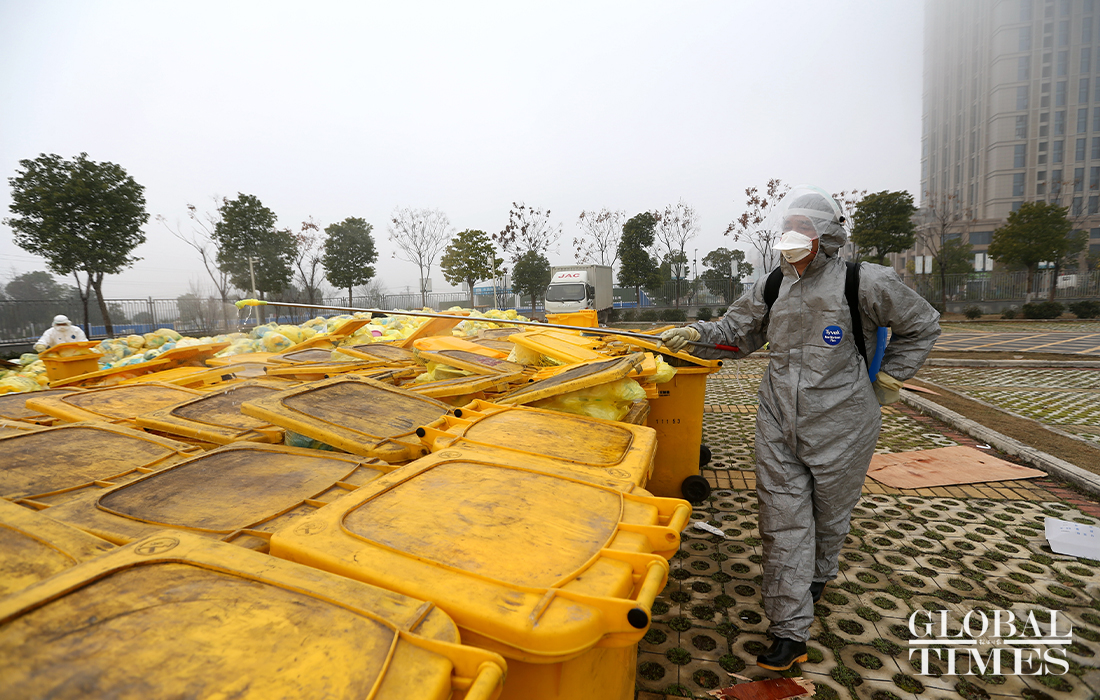 A worker disinfects garbage bins that contained medical waste, in Wuhan, on Feb 22. He was working as a greenery worker at a hospital before he was drafted in to meet the shortage of medical waste handlers. Similarly, many employees who were working in the hospital's logistics department had to switch jobs. Photo: Cui Meng/GT
A worker disinfects garbage bins that contained medical waste, in Wuhan, on Feb 22. He was working as a greenery worker at a hospital before he was drafted in to meet the shortage of medical waste handlers. Similarly, many employees who were working in the hospital's logistics department had to switch jobs. Photo: Cui Meng/GT 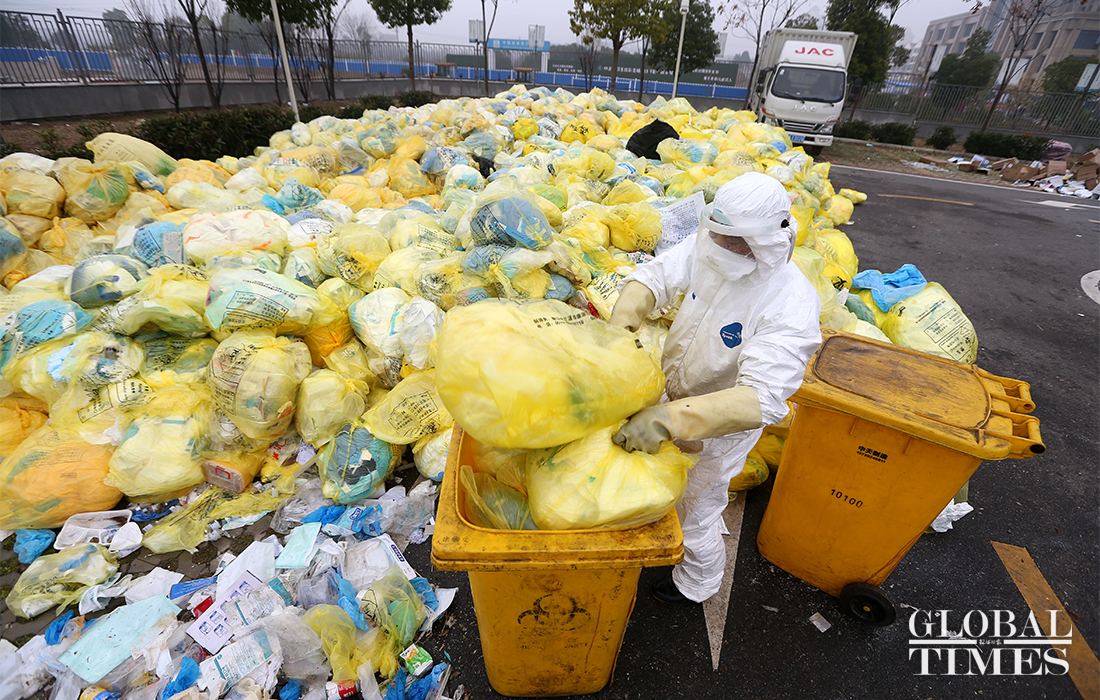 A worker picks the waste bags from an ashcan to take them to the temporary medical waste storage point, in Wuhan, on February 22. Photo: Cui Meng/GT
A worker picks the waste bags from an ashcan to take them to the temporary medical waste storage point, in Wuhan, on February 22. Photo: Cui Meng/GT 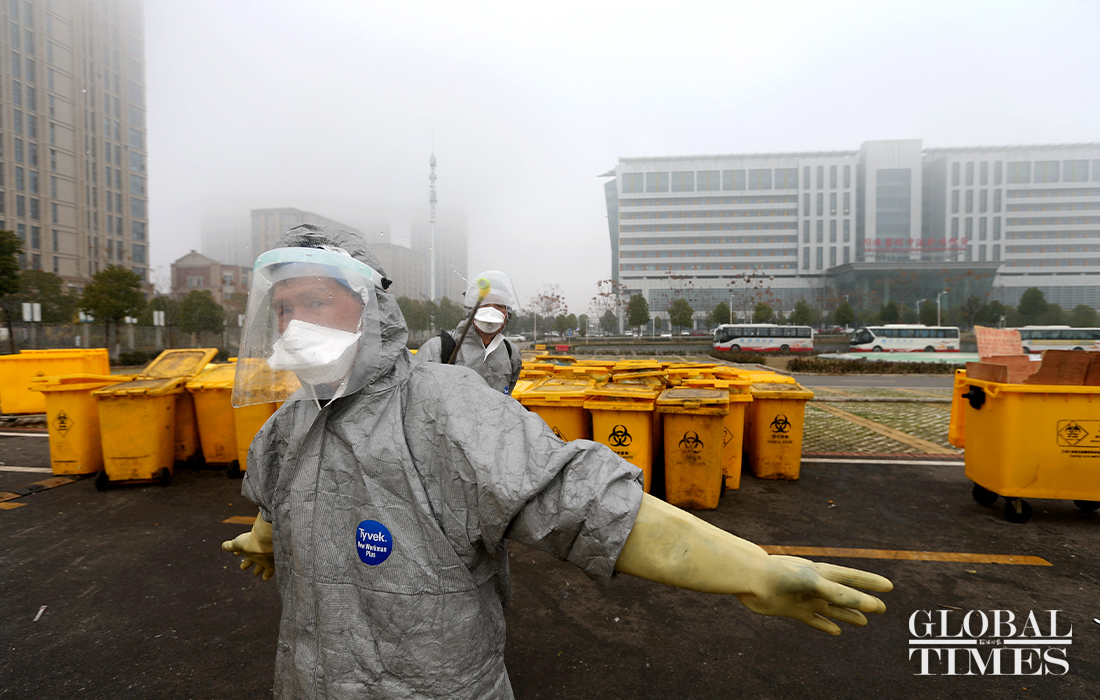 A worker is undergoing full-body disinfection, on Feb 22, in Wuhan. Photo: Cui Meng/GT
A worker is undergoing full-body disinfection, on Feb 22, in Wuhan. Photo: Cui Meng/GT 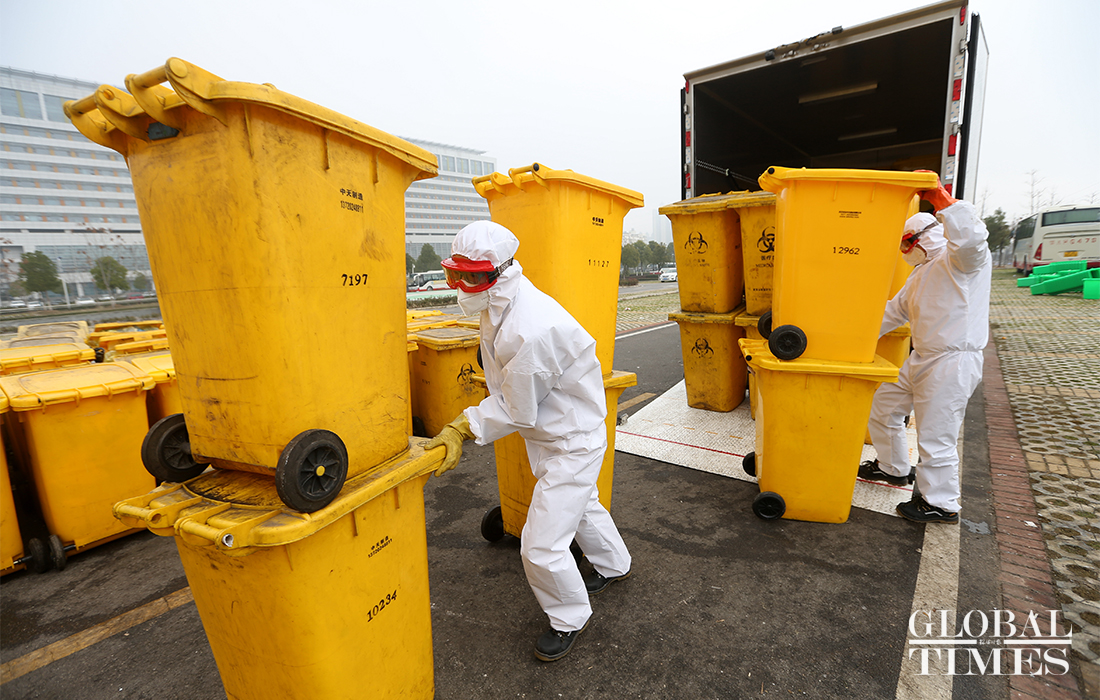 Members of a professional garbage disposal team from Nanjing, East China's Jiangsu Province, transfer infectious medical waste in Tongji Hospital, Wuhan, on Feb 22. Photo: Cui Meng/GT
Members of a professional garbage disposal team from Nanjing, East China's Jiangsu Province, transfer infectious medical waste in Tongji Hospital, Wuhan, on Feb 22. Photo: Cui Meng/GT 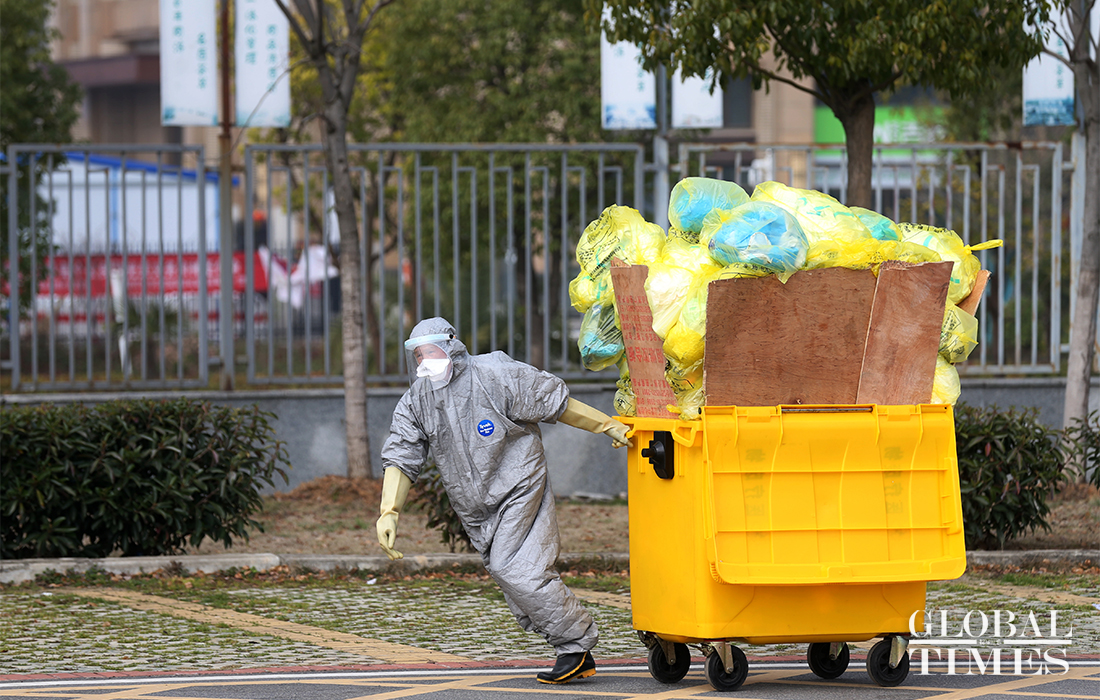 A worker transfers the medical waste to a temporary storage point on Feb 22. Photo: Cui Meng/GT
A worker transfers the medical waste to a temporary storage point on Feb 22. Photo: Cui Meng/GT 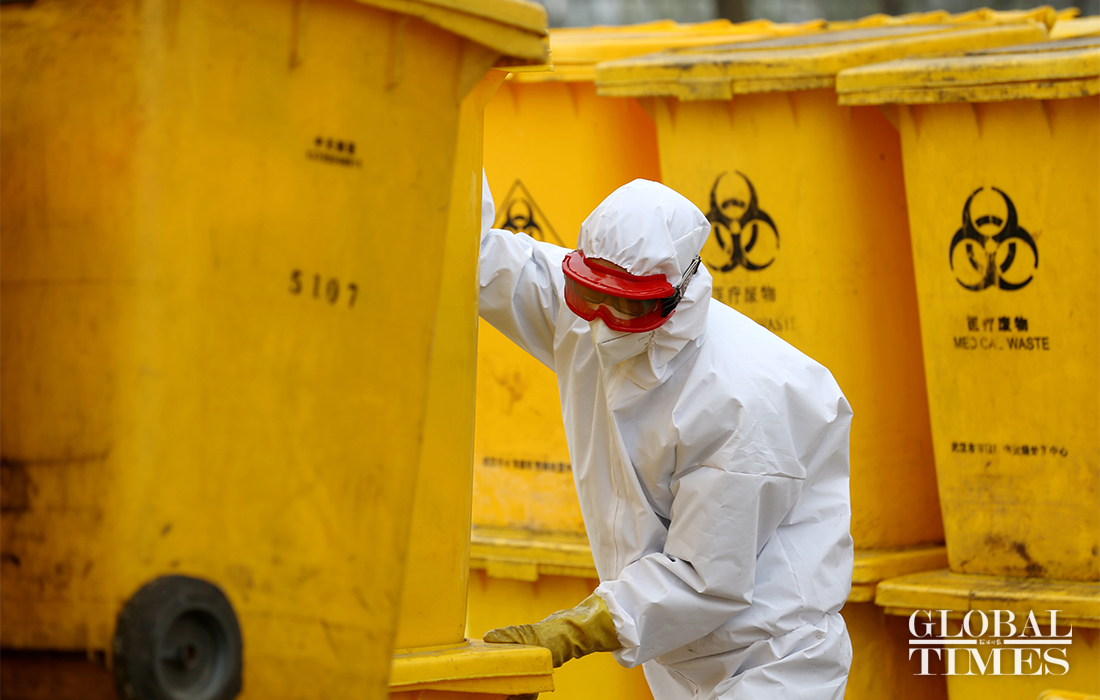 A member of a professional garbage disposal team from Nanjing, East China's Jiangsu Province, transfers infectious medical waste in Tongji Hospital, Wuhan. Nanjing has sent two medical waste transfer vehicles and four professionals to help Wuhan with garbage disposal, besides the reinforcement staff is likely to arrive soon. Photo: Cui Meng/GT
A member of a professional garbage disposal team from Nanjing, East China's Jiangsu Province, transfers infectious medical waste in Tongji Hospital, Wuhan. Nanjing has sent two medical waste transfer vehicles and four professionals to help Wuhan with garbage disposal, besides the reinforcement staff is likely to arrive soon. Photo: Cui Meng/GT 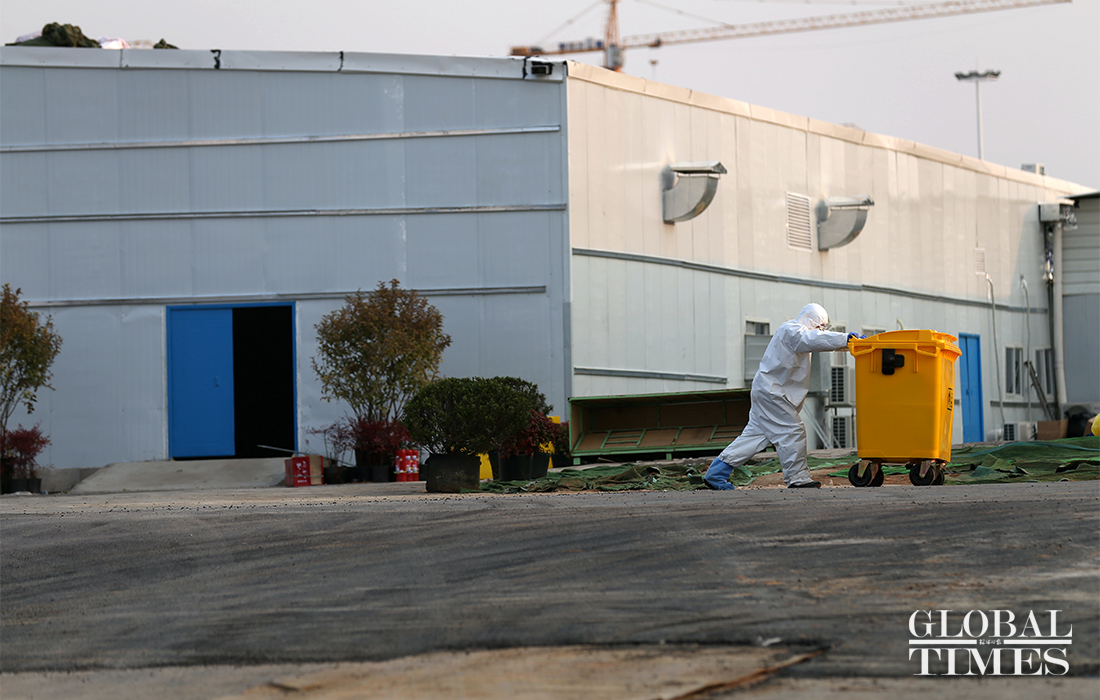 A worker in Wuhan’s Leishenshan Hospital, transfers medical waste, on Feb 23. Photo: Cui Meng/GT
A worker in Wuhan’s Leishenshan Hospital, transfers medical waste, on Feb 23. Photo: Cui Meng/GT 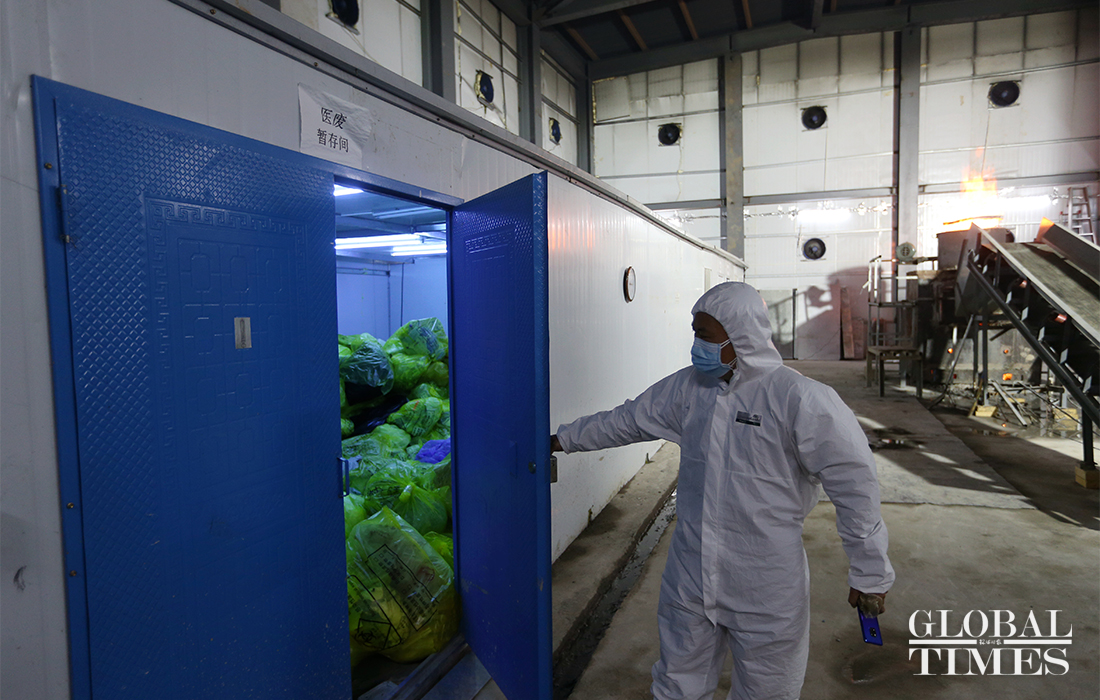 The interiors of a temporary storage warehouse for the incineration of medical waste at Leishenshan Hospital, equipped with 24-hour UV disinfection. Photo: Cui Meng/GT
The interiors of a temporary storage warehouse for the incineration of medical waste at Leishenshan Hospital, equipped with 24-hour UV disinfection. Photo: Cui Meng/GT 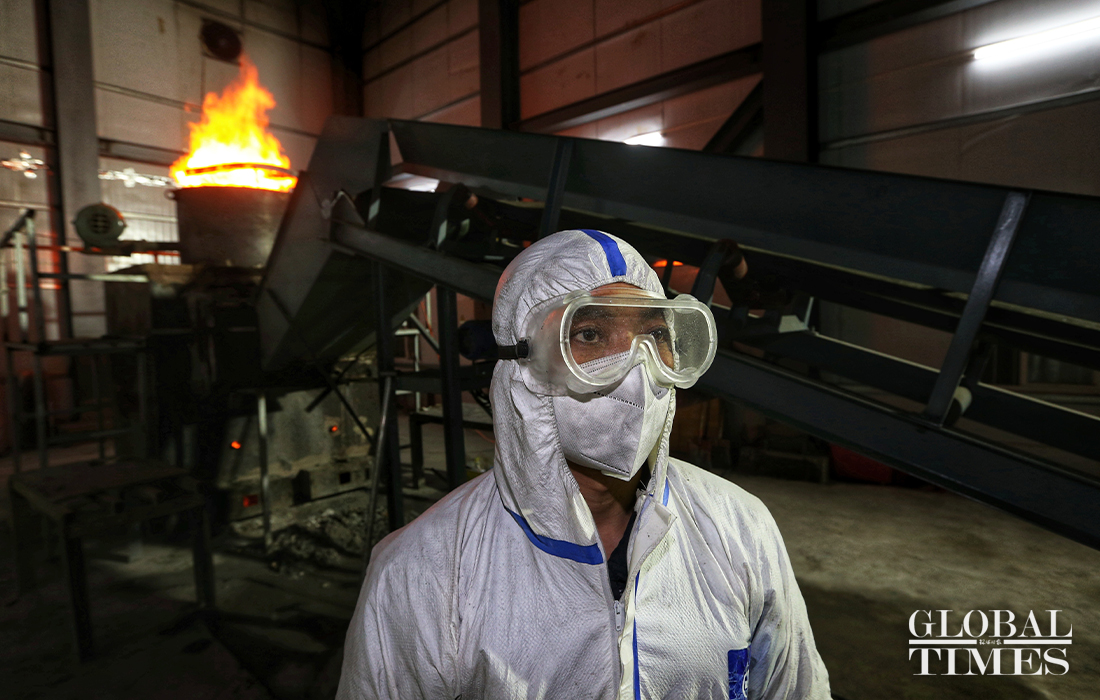 A volunteer in the medical waste incineration workshop at Leishenshan Hospital. Photo: Cui Meng/GT
A volunteer in the medical waste incineration workshop at Leishenshan Hospital. Photo: Cui Meng/GT 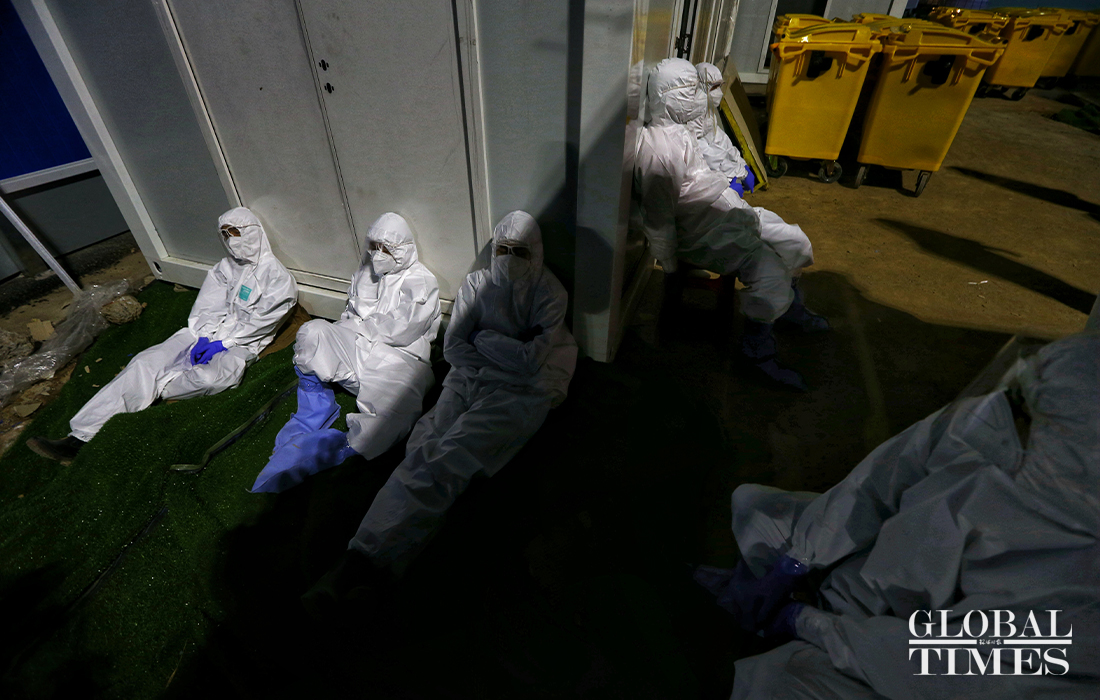 Volunteers take a short break during disposal process of medical waste in Leishenshan Hospital, Wuhan, on Feb 23. Photo: Cui Meng/GT
Volunteers take a short break during disposal process of medical waste in Leishenshan Hospital, Wuhan, on Feb 23. Photo: Cui Meng/GT 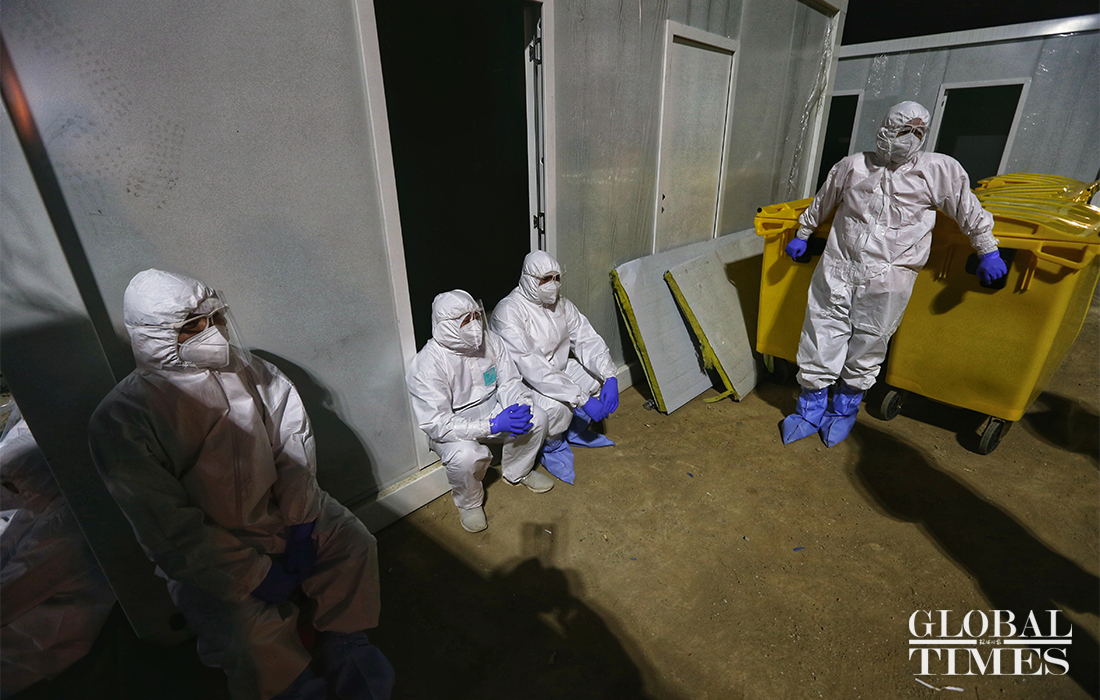 Volunteers take a short break during disposal process of medical waste in Leishenshan Hospital, Wuhan, on Feb 23. Photo: Cui Meng/GT
Volunteers take a short break during disposal process of medical waste in Leishenshan Hospital, Wuhan, on Feb 23. Photo: Cui Meng/GT 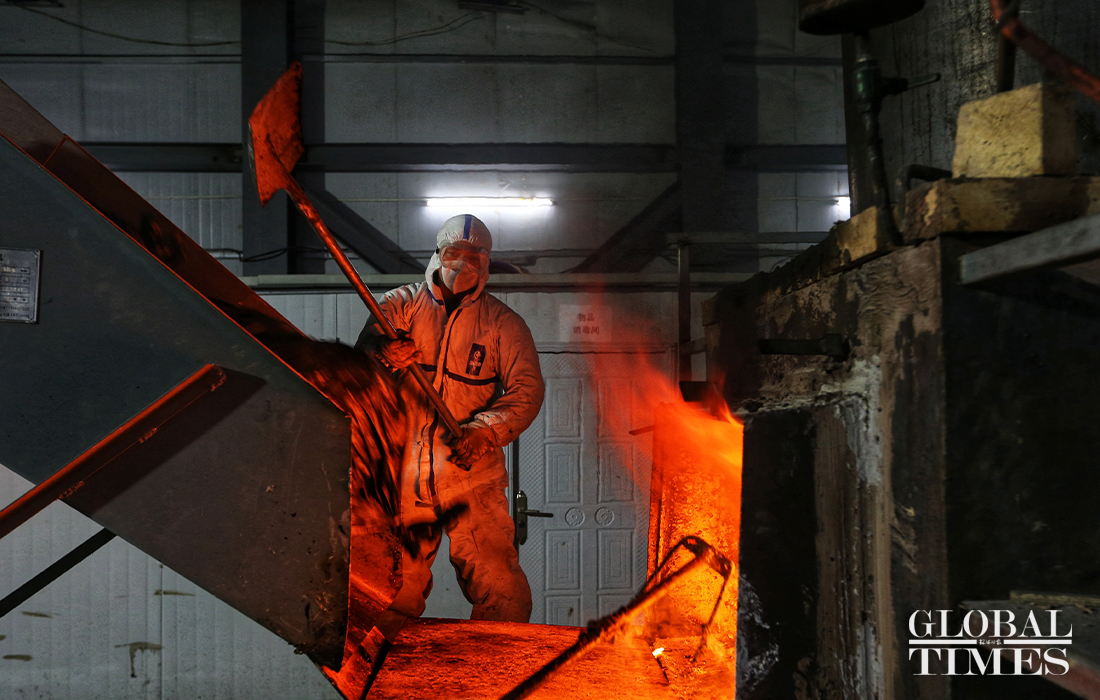 A worker disposes of infectious medical waste at the medical waste incineration workshop of Leishenshan Hospital, on Feb 23. Photo: Cui Meng/GT
A worker disposes of infectious medical waste at the medical waste incineration workshop of Leishenshan Hospital, on Feb 23. Photo: Cui Meng/GT 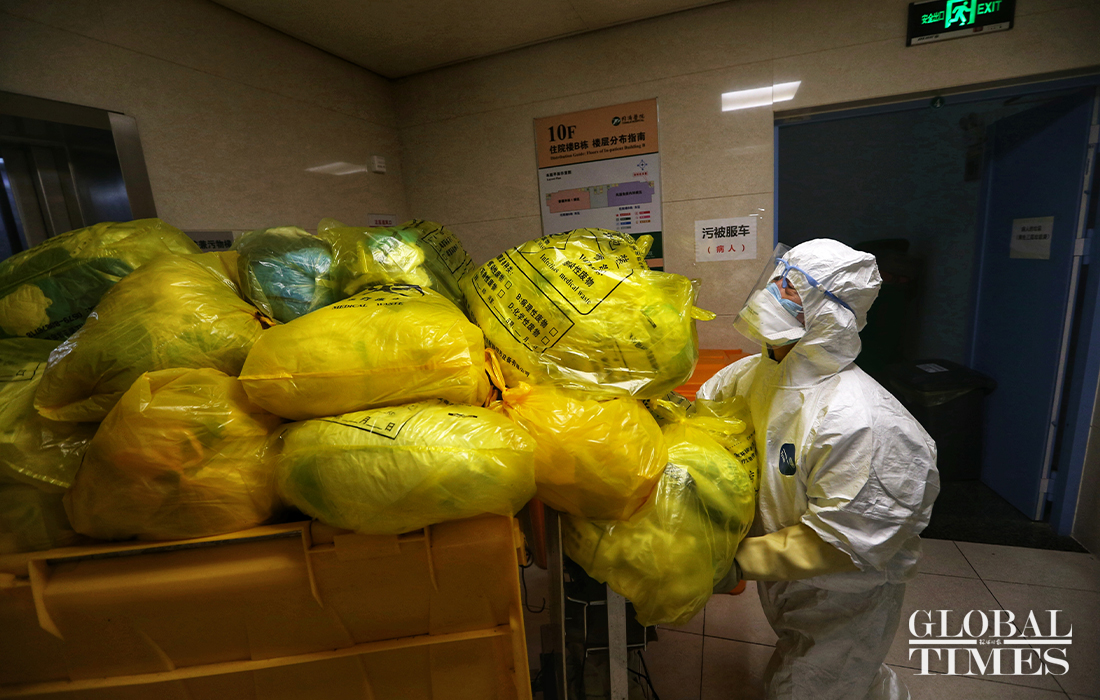 A worker transports medical waste from the quarantine area to the underground temporary storage warehouse, on Feb 24. Every morning at 5:30 their shift begins, as they prepare for a 12-hour long work time . Photo: Cui Meng/GT
A worker transports medical waste from the quarantine area to the underground temporary storage warehouse, on Feb 24. Every morning at 5:30 their shift begins, as they prepare for a 12-hour long work time . Photo: Cui Meng/GT 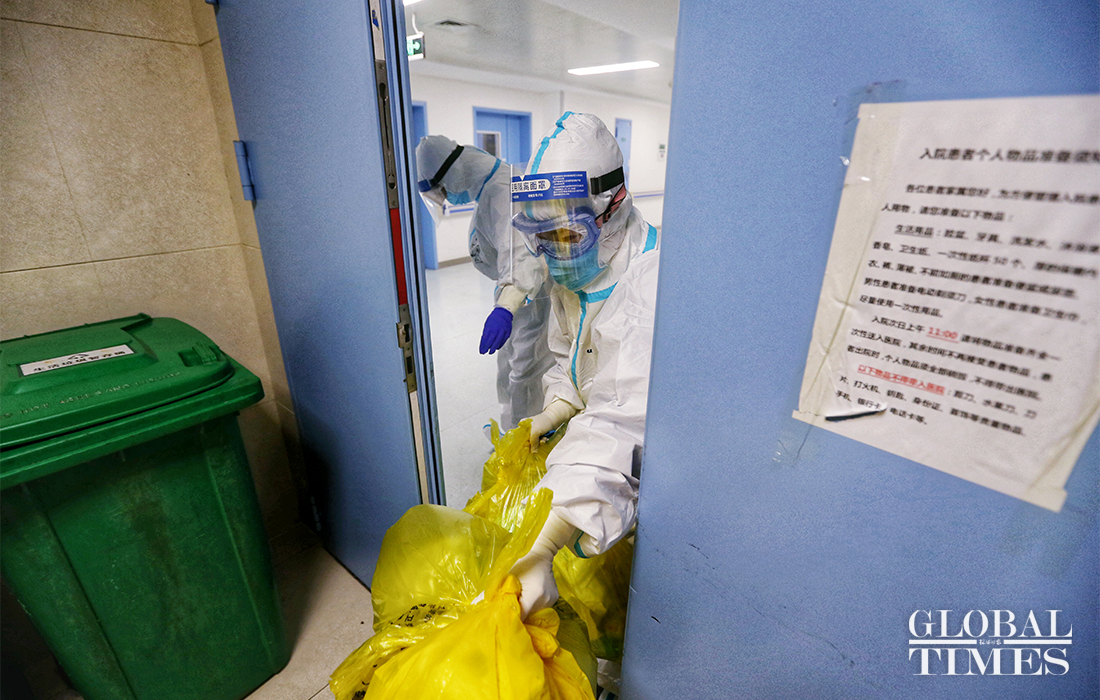 A nurse collects medical waste generated over the night in the critical patient ward for disposal, on the morning of Feb 24. Photo: Cui Meng/GT
A nurse collects medical waste generated over the night in the critical patient ward for disposal, on the morning of Feb 24. Photo: Cui Meng/GT 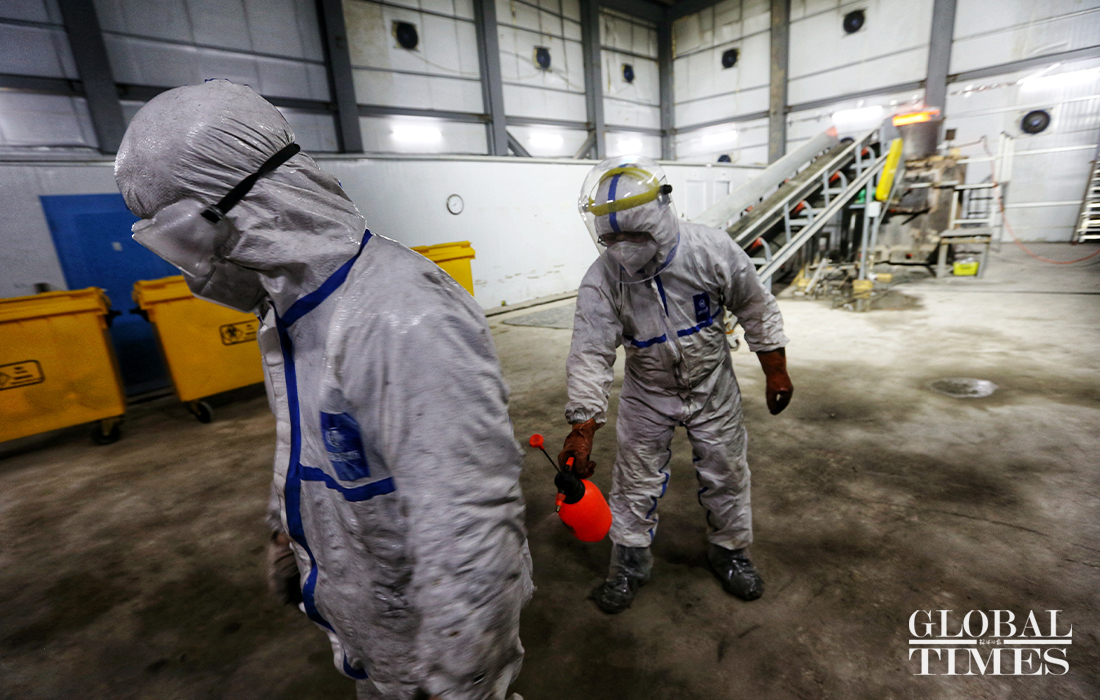 Workers conduct disinfection after finishing 10 hours of work at the medical waste incineration workshop of Leishenshan Hospital, on Feb 23. Photo: Cui Meng/GT
Workers conduct disinfection after finishing 10 hours of work at the medical waste incineration workshop of Leishenshan Hospital, on Feb 23. Photo: Cui Meng/GT 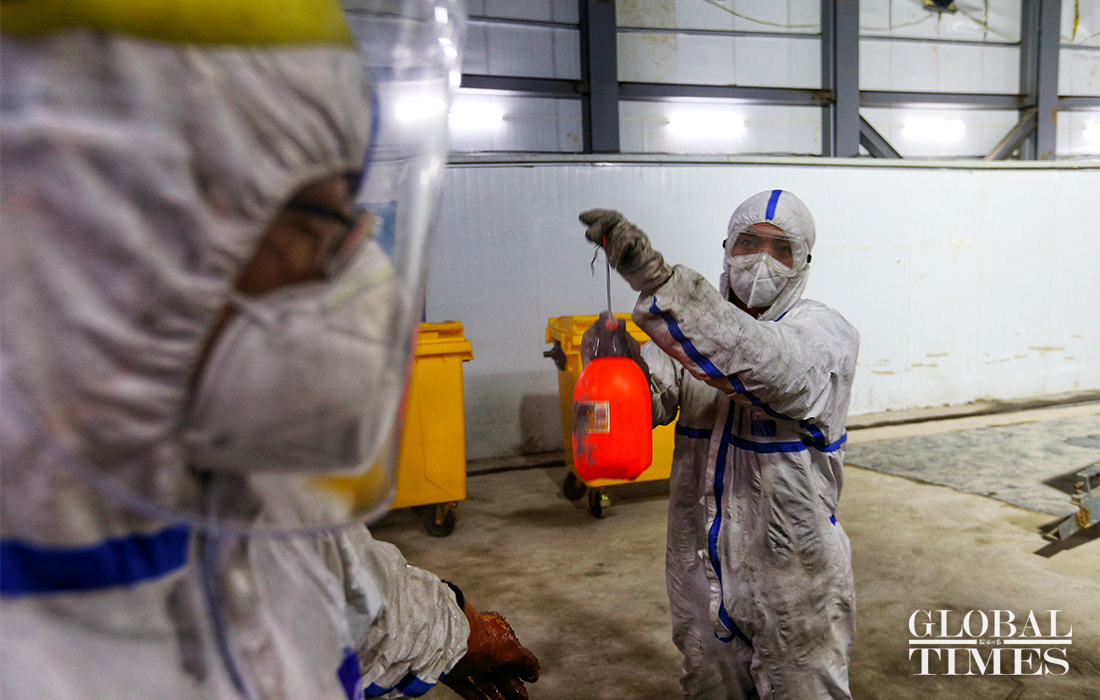 Workers conduct disinfection after finishing 10 hours of work at the medical waste incineration workshop of Leishenshan Hospital, on Feb 23. Photo: Cui Meng/GT
Workers conduct disinfection after finishing 10 hours of work at the medical waste incineration workshop of Leishenshan Hospital, on Feb 23. Photo: Cui Meng/GT 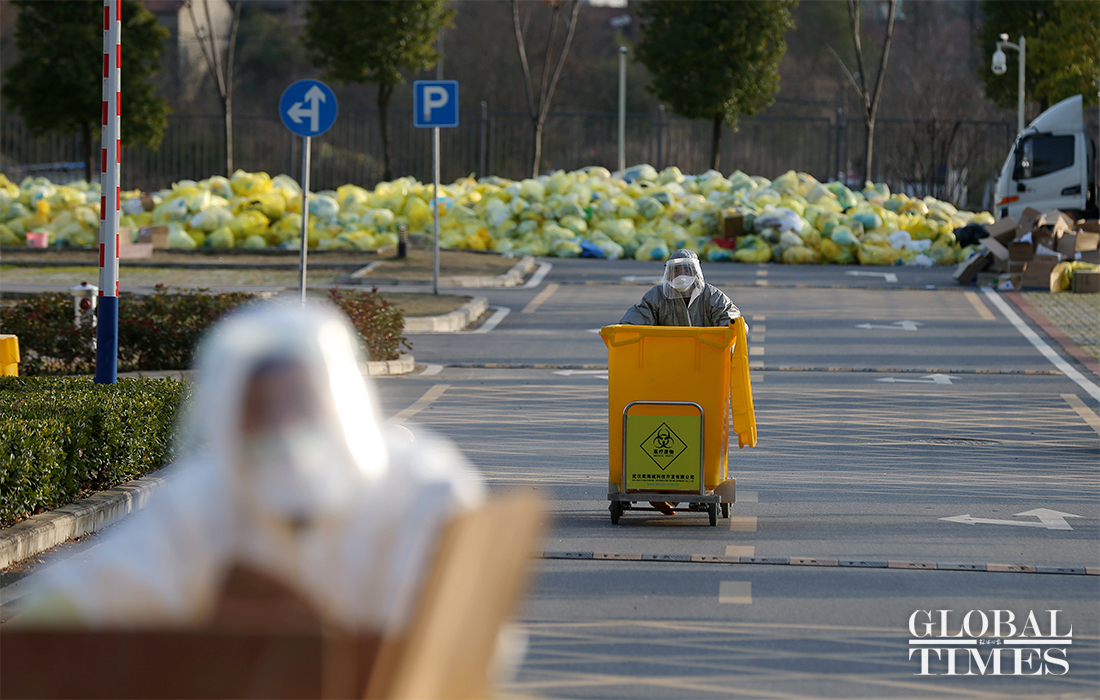 Photo: Cui Meng/GT
Photo: Cui Meng/GT 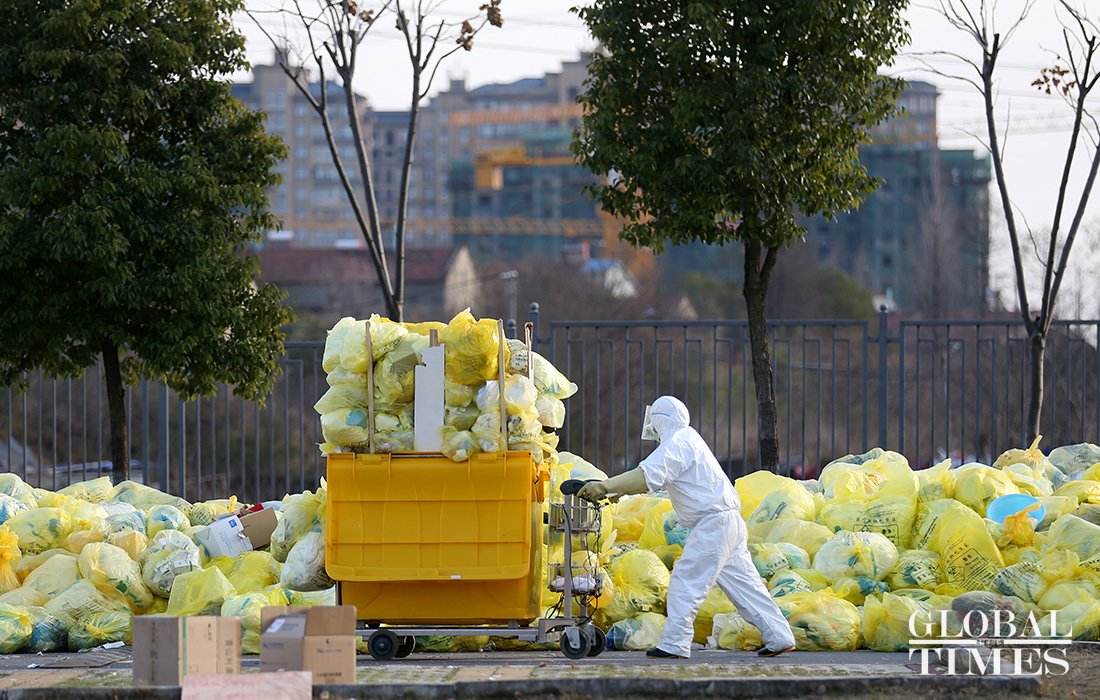 A worker pushes a trolley full of infectious medical waste in the Zhongfa Xincheng branch of Wuhan Tongji Hospital on February 18. Photo: Cui Meng/GT
A worker pushes a trolley full of infectious medical waste in the Zhongfa Xincheng branch of Wuhan Tongji Hospital on February 18. Photo: Cui Meng/GT 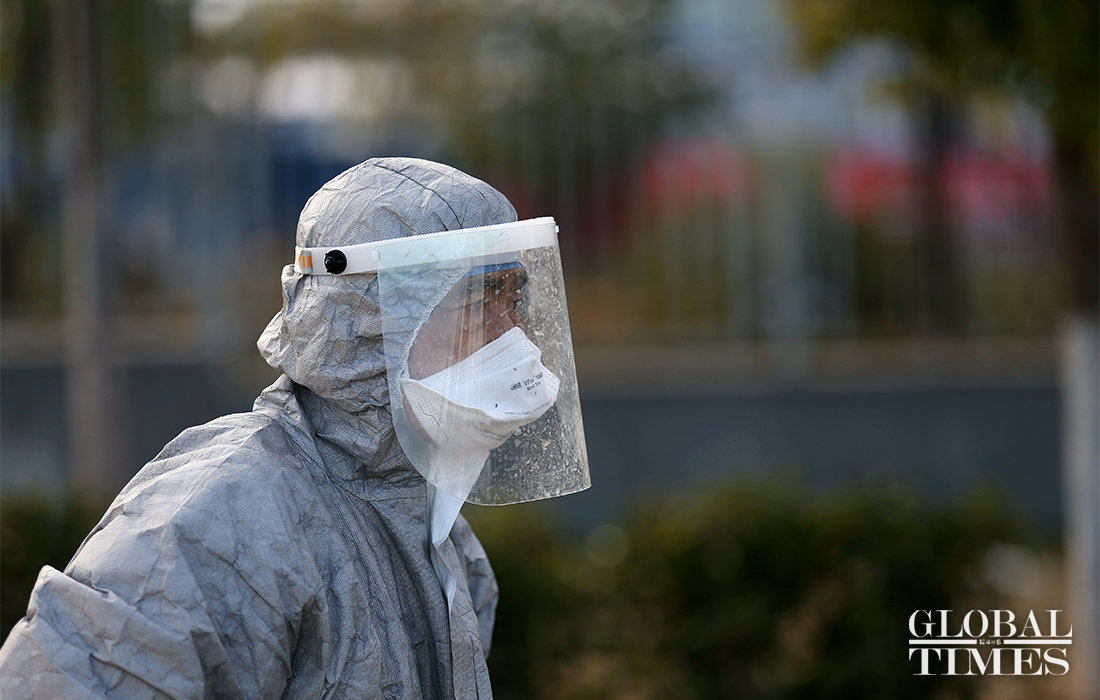 Photo: Cui Meng/GT
Photo: Cui Meng/GT 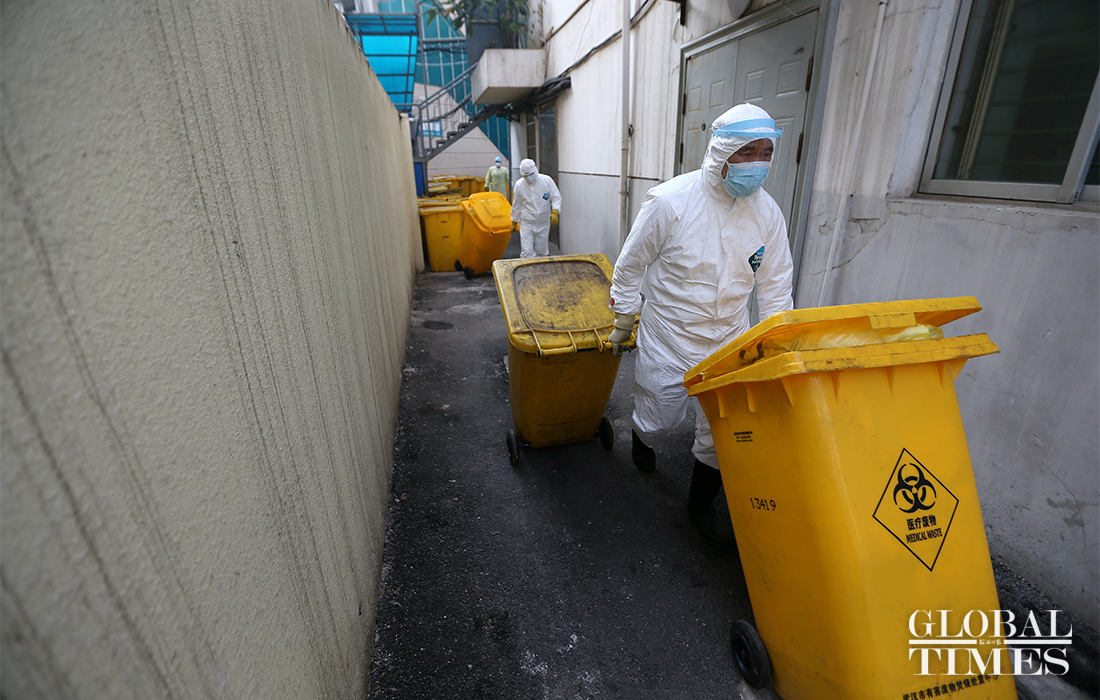 Workers arrange garbage bins containing medical waste to load them in a truck and transport to the disposal point, in Wuhan Red Cross Society Hospital, on Feb 22. Photo: Cui Meng/GT
Workers arrange garbage bins containing medical waste to load them in a truck and transport to the disposal point, in Wuhan Red Cross Society Hospital, on Feb 22. Photo: Cui Meng/GT 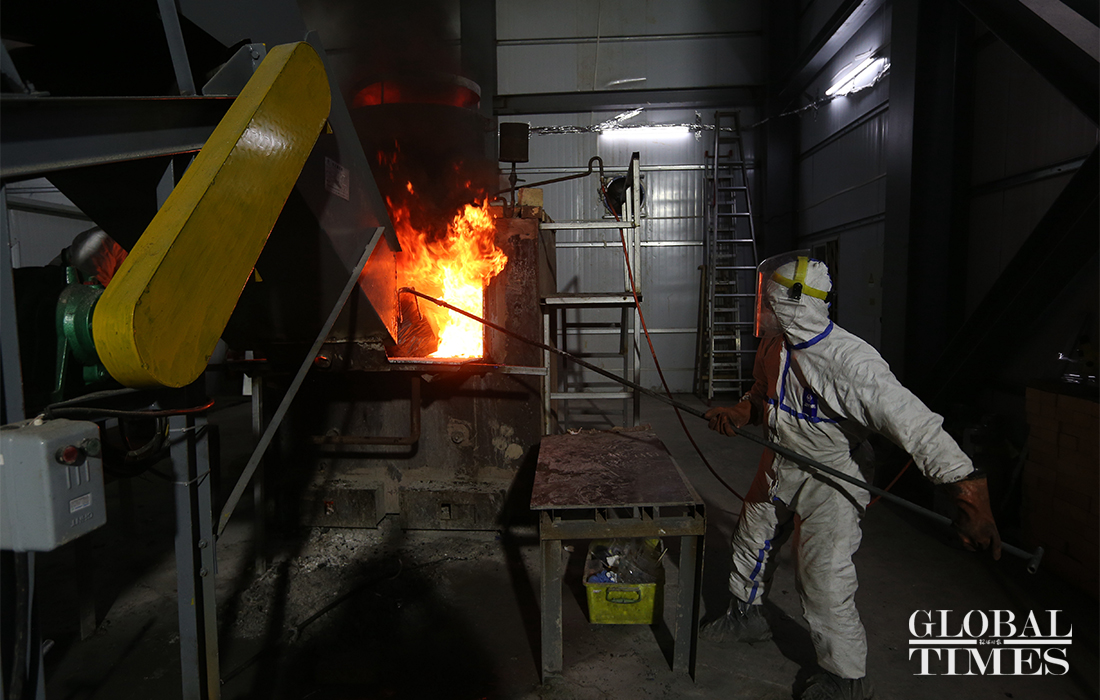 A worker disposes of infectious medical waste at the medical waste incineration workshop of Leishenshan Hospital, on Feb 23. Photo: Cui Meng/GT
A worker disposes of infectious medical waste at the medical waste incineration workshop of Leishenshan Hospital, on Feb 23. Photo: Cui Meng/GT 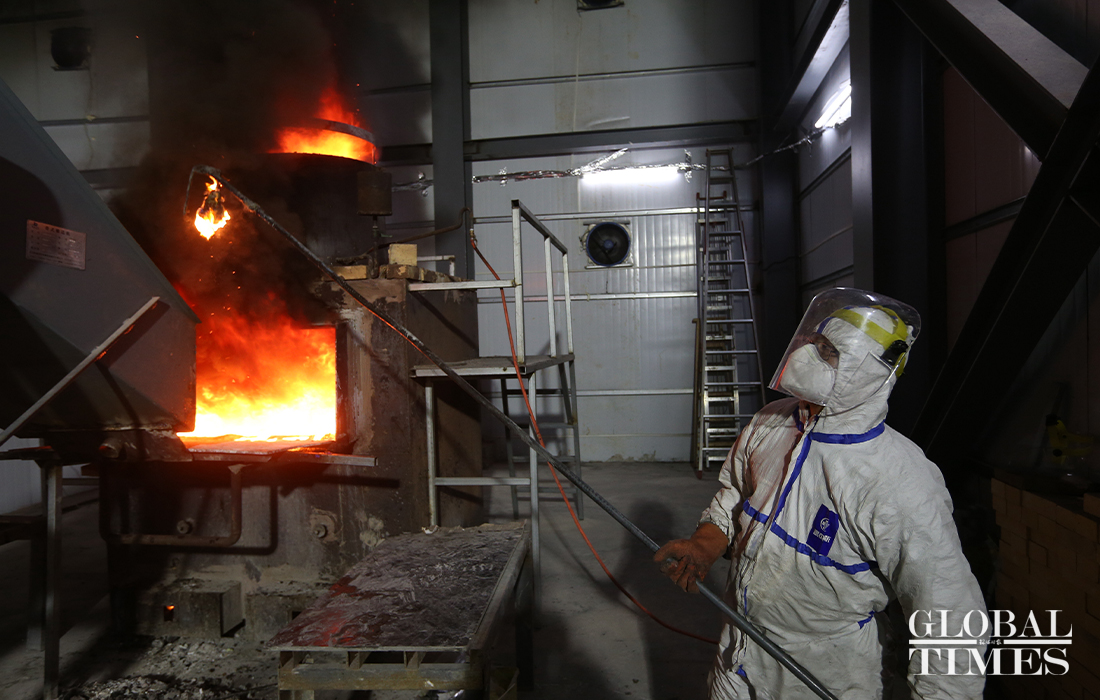 A worker disposes of infectious medical waste at the medical waste incineration workshop of Leishenshan Hospital, on Feb 23. Photo: Cui Meng/GT
A worker disposes of infectious medical waste at the medical waste incineration workshop of Leishenshan Hospital, on Feb 23. Photo: Cui Meng/GT 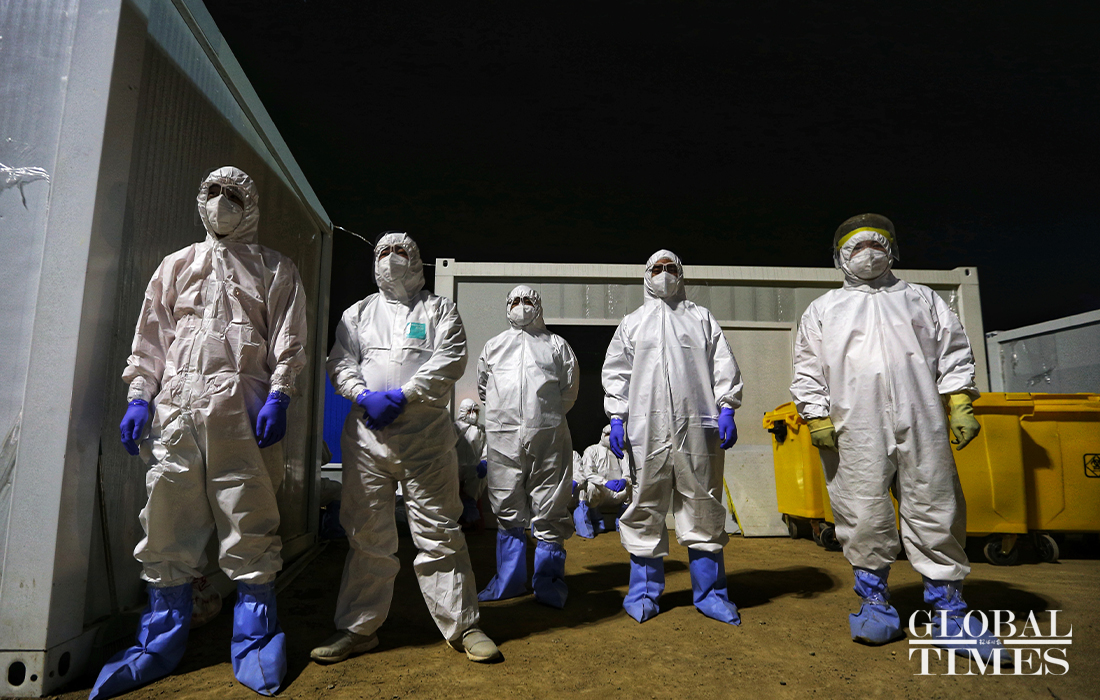 Photo: Cui Meng/GT
Photo: Cui Meng/GT 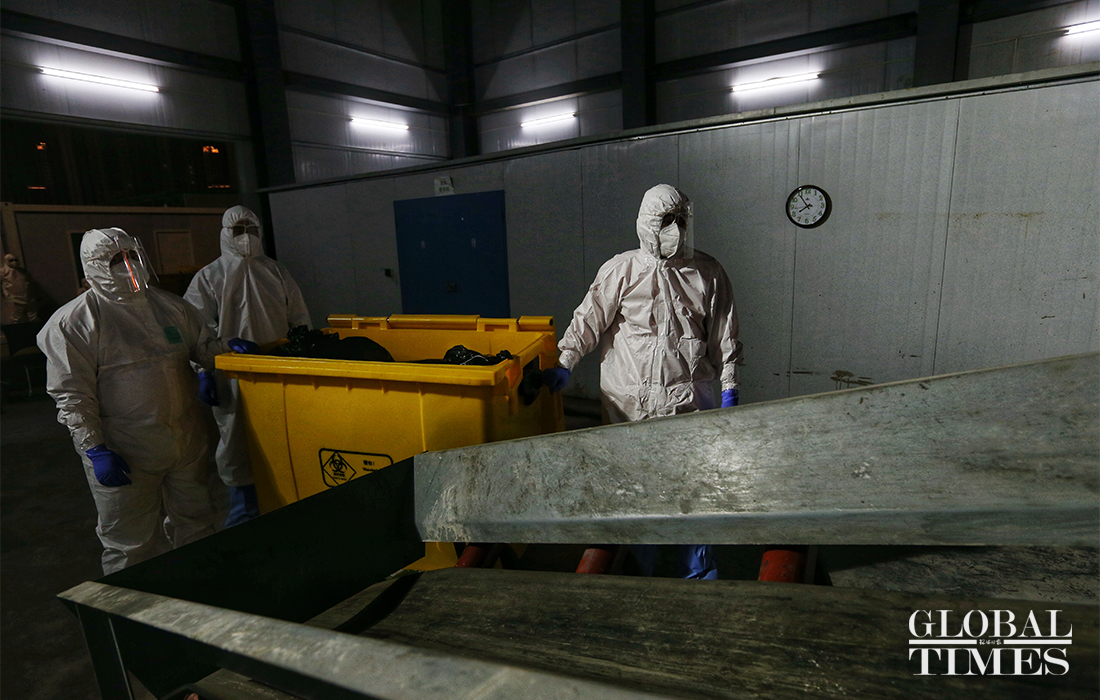 Photo: Cui Meng/GT
Photo: Cui Meng/GT 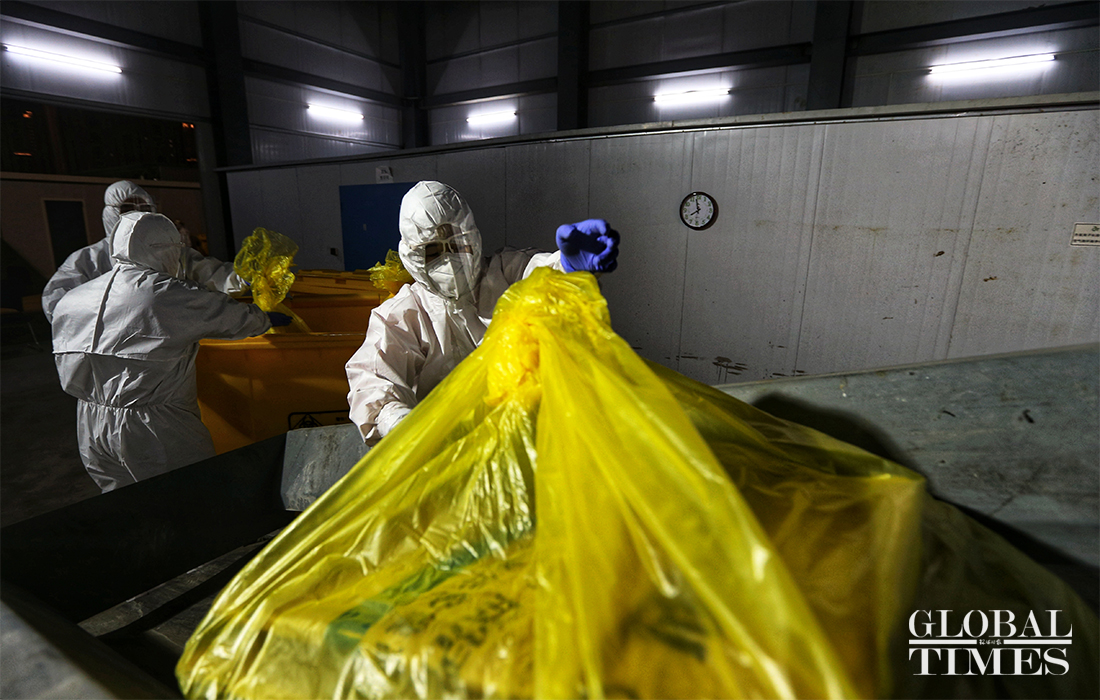 Photo: Cui Meng/GT
Photo: Cui Meng/GT 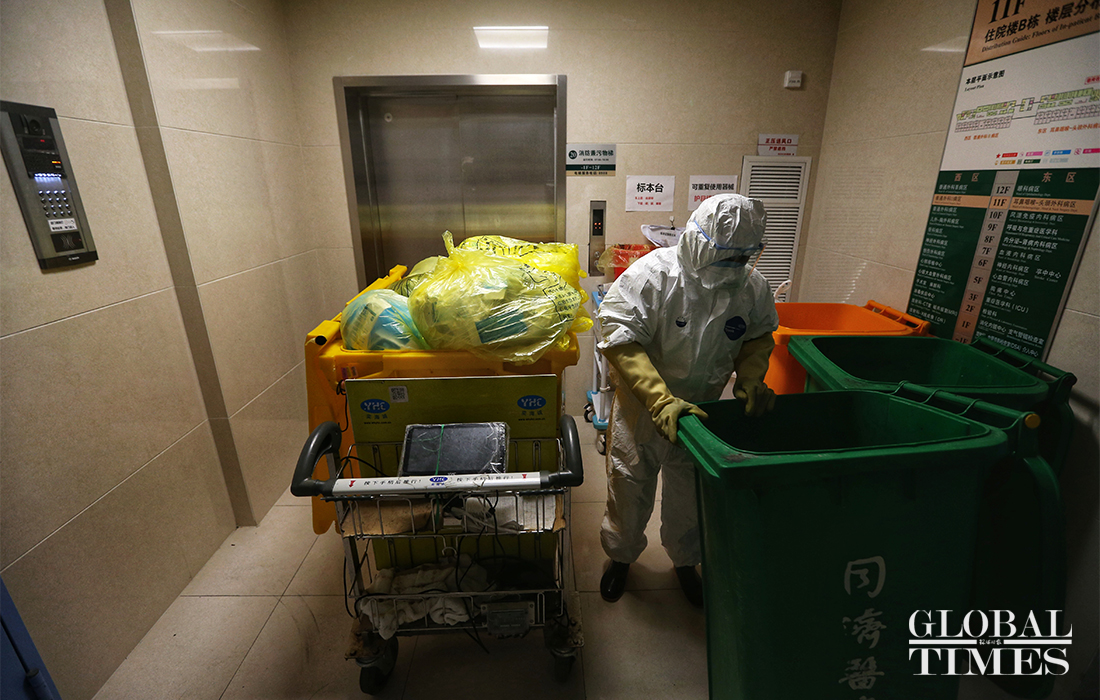 A worker transports medical waste from the quarantine area to the underground temporary storage warehouse, on Feb 24. Every morning at 5:30 their shift begins, as they prepare for a 12-hour long work time . Photo: Cui Meng/GT
A worker transports medical waste from the quarantine area to the underground temporary storage warehouse, on Feb 24. Every morning at 5:30 their shift begins, as they prepare for a 12-hour long work time . Photo: Cui Meng/GT 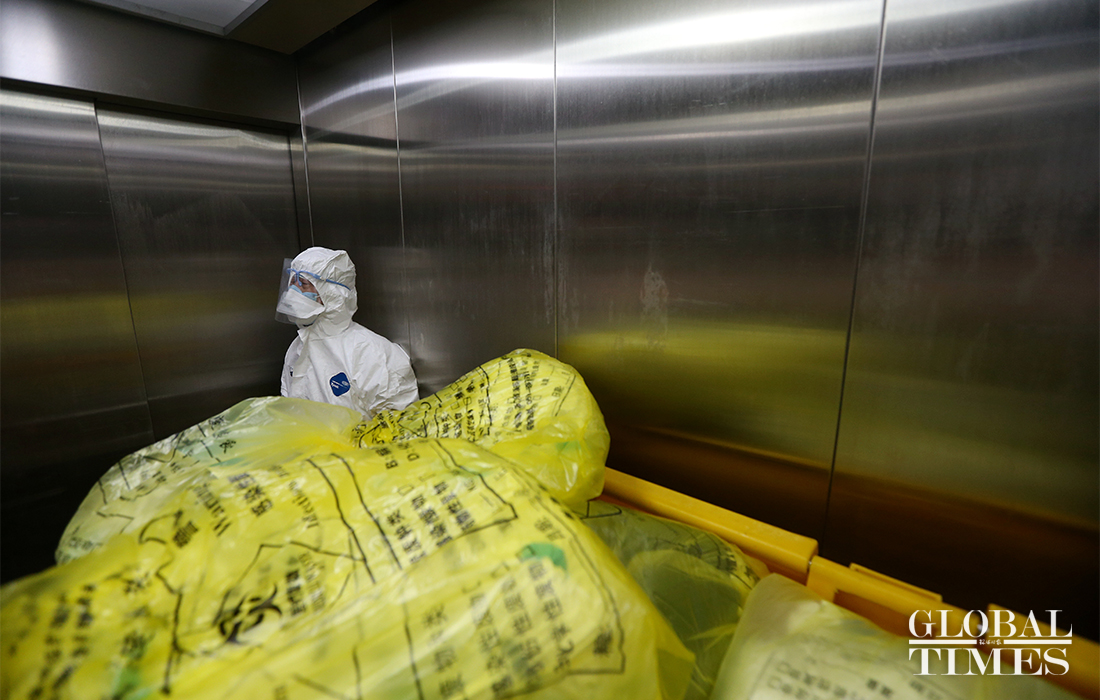 A worker transports medical waste from the quarantine area to the underground temporary storage warehouse, on Feb 24. Every morning at 5:30 their shift begins, as they prepare for a 12-hour long work time . Photo: Cui Meng/GT
A worker transports medical waste from the quarantine area to the underground temporary storage warehouse, on Feb 24. Every morning at 5:30 their shift begins, as they prepare for a 12-hour long work time . Photo: Cui Meng/GT 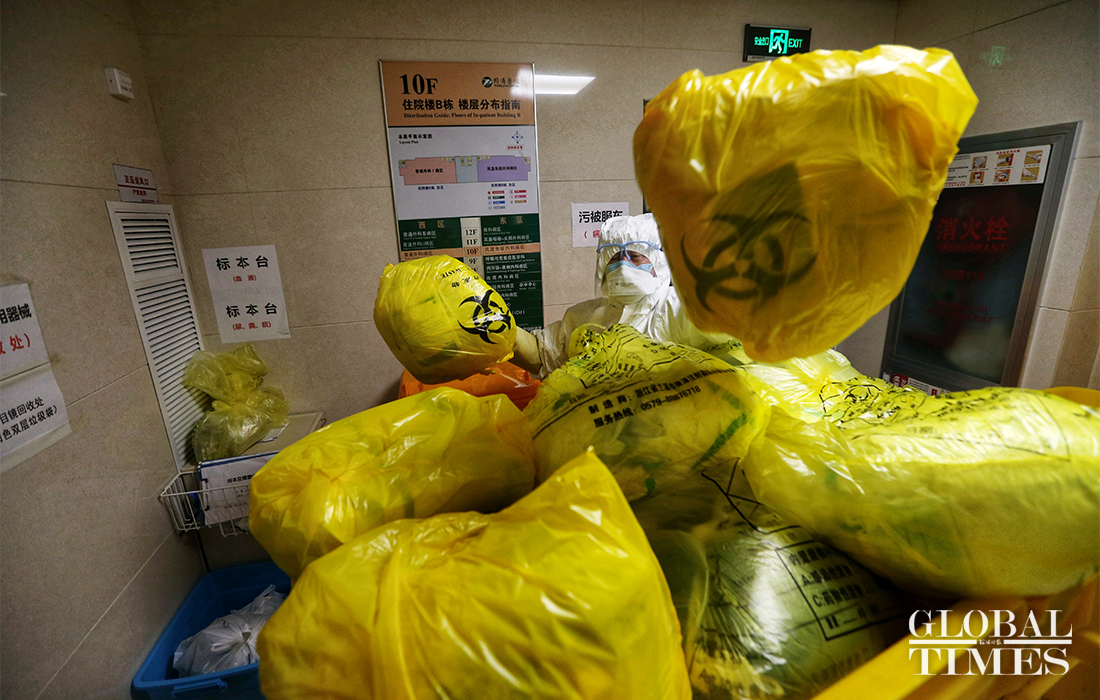 A worker transports medical waste from the quarantine area to the underground temporary storage warehouse, on Feb 24. Every morning at 5:30 their shift begins, as they prepare for a 12-hour long work time . Photo: Cui Meng/GT
A worker transports medical waste from the quarantine area to the underground temporary storage warehouse, on Feb 24. Every morning at 5:30 their shift begins, as they prepare for a 12-hour long work time . Photo: Cui Meng/GT 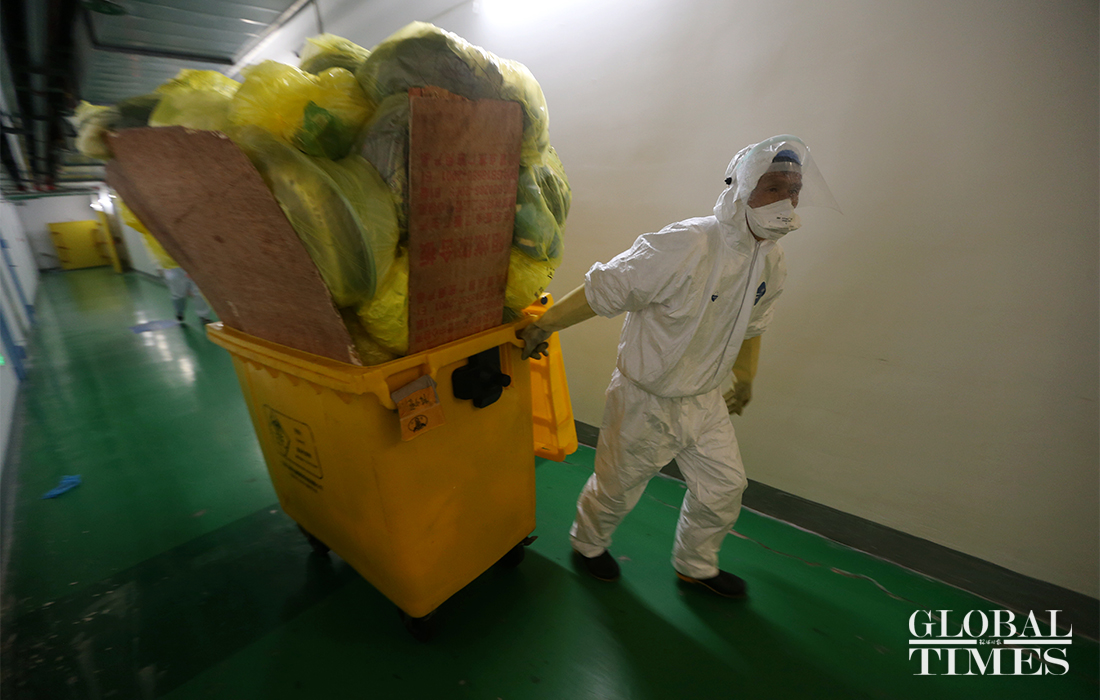 A worker transports medical waste from the quarantine area to the underground temporary storage warehouse, on Feb 24. Every morning at 5:30 their shift begins, as they prepare for a 12-hour long work time . Photo: Cui Meng/GT
A worker transports medical waste from the quarantine area to the underground temporary storage warehouse, on Feb 24. Every morning at 5:30 their shift begins, as they prepare for a 12-hour long work time . Photo: Cui Meng/GT 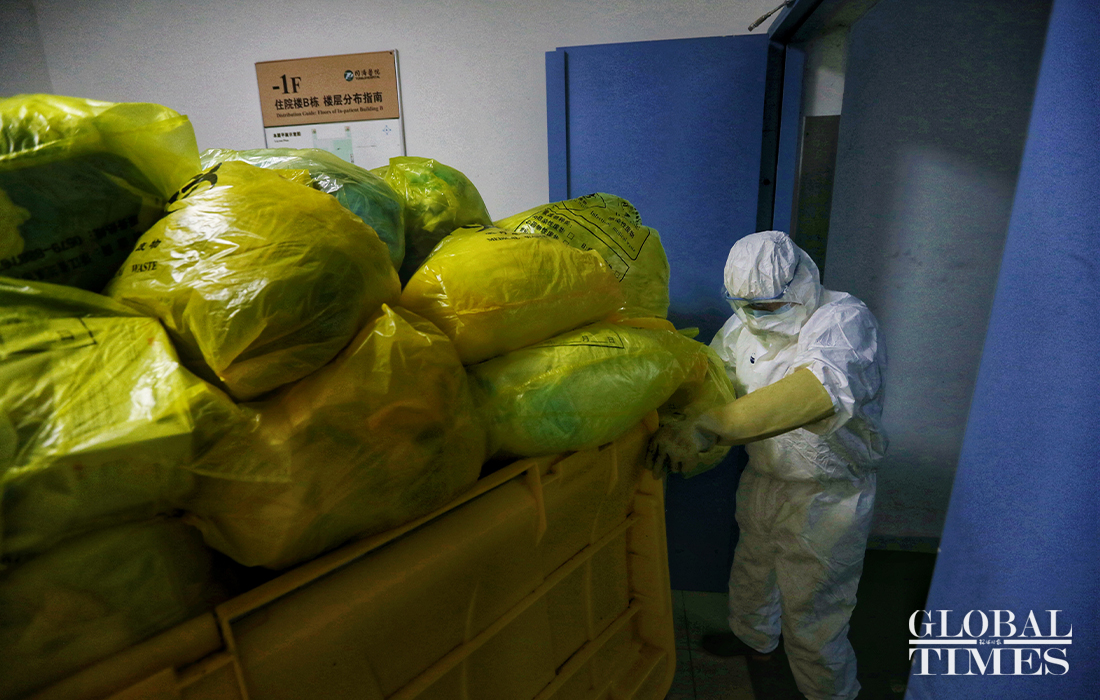 A worker transports medical waste from the quarantine area to the underground temporary storage warehouse, on Feb 24. Every morning at 5:30 their shift begins, as they prepare for a 12-hour long work time . Photo: Cui Meng/GT
A worker transports medical waste from the quarantine area to the underground temporary storage warehouse, on Feb 24. Every morning at 5:30 their shift begins, as they prepare for a 12-hour long work time . Photo: Cui Meng/GT 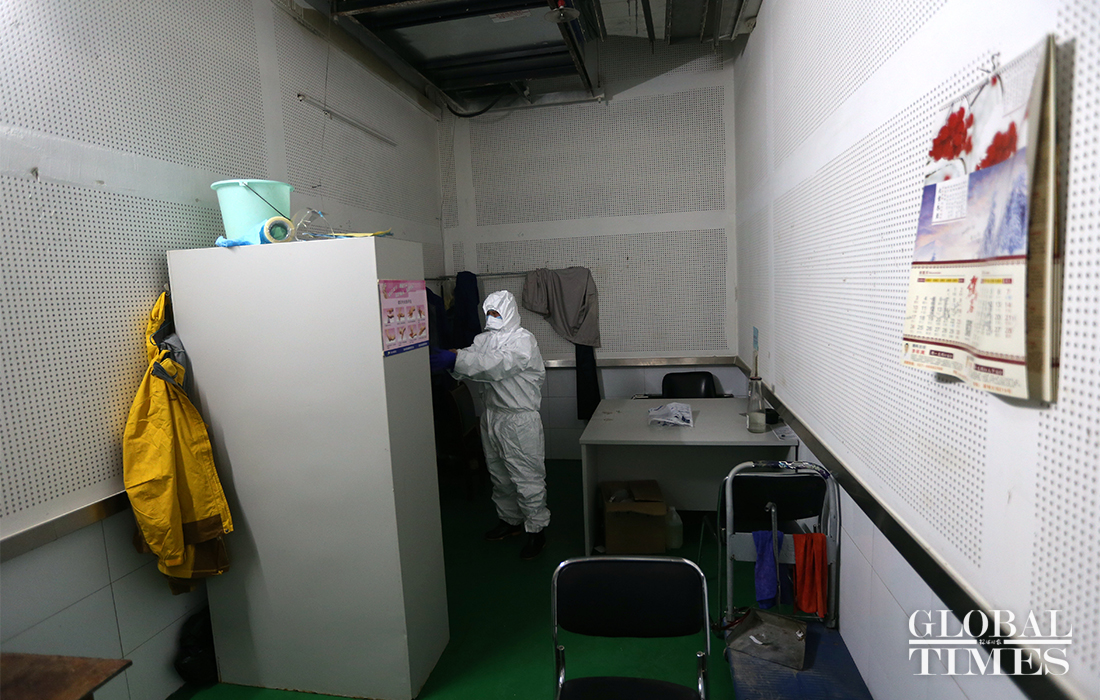 Photo: Cui Meng/GT
Photo: Cui Meng/GT 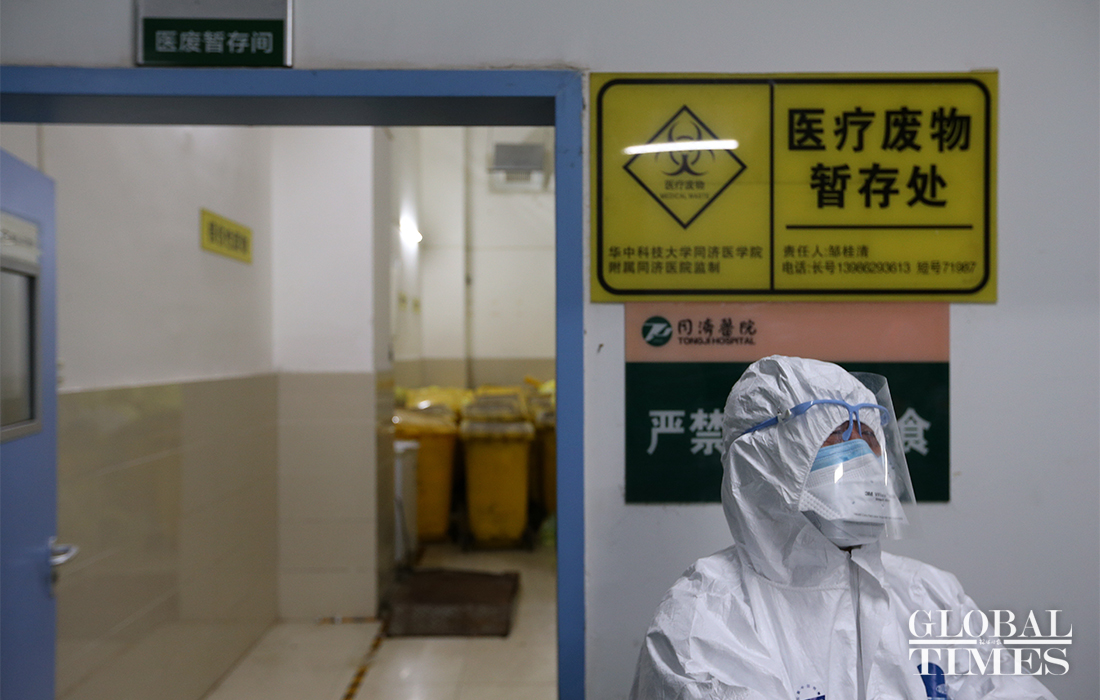 Photo: Cui Meng/GT
Photo: Cui Meng/GT 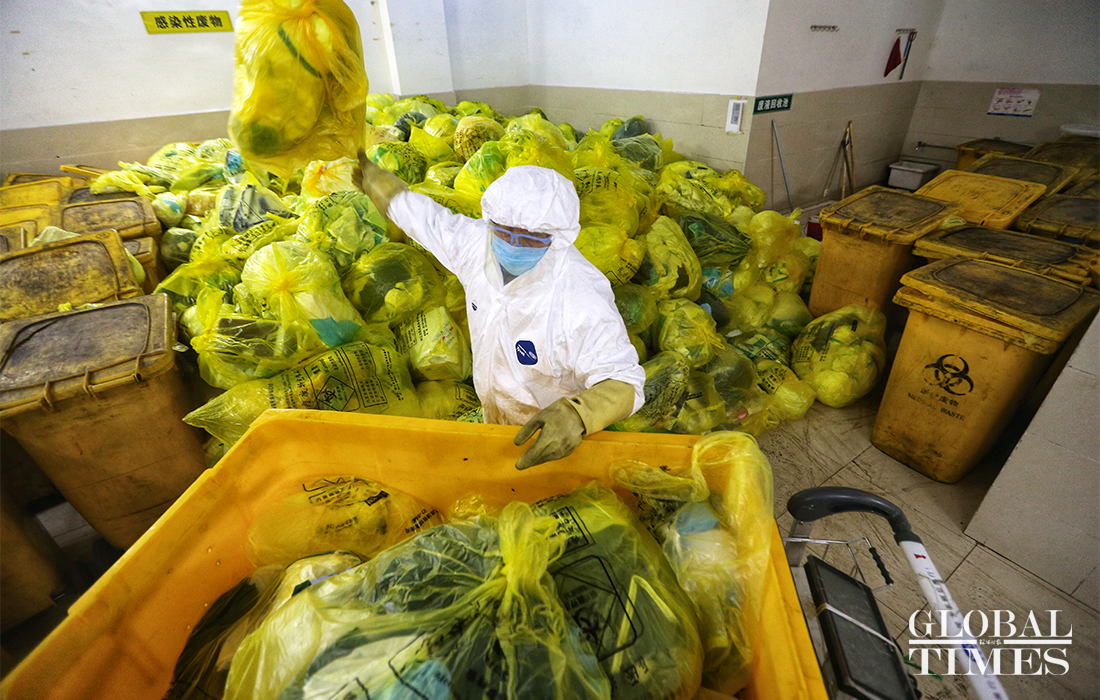 Photo: Cui Meng/GT
Photo: Cui Meng/GT









































